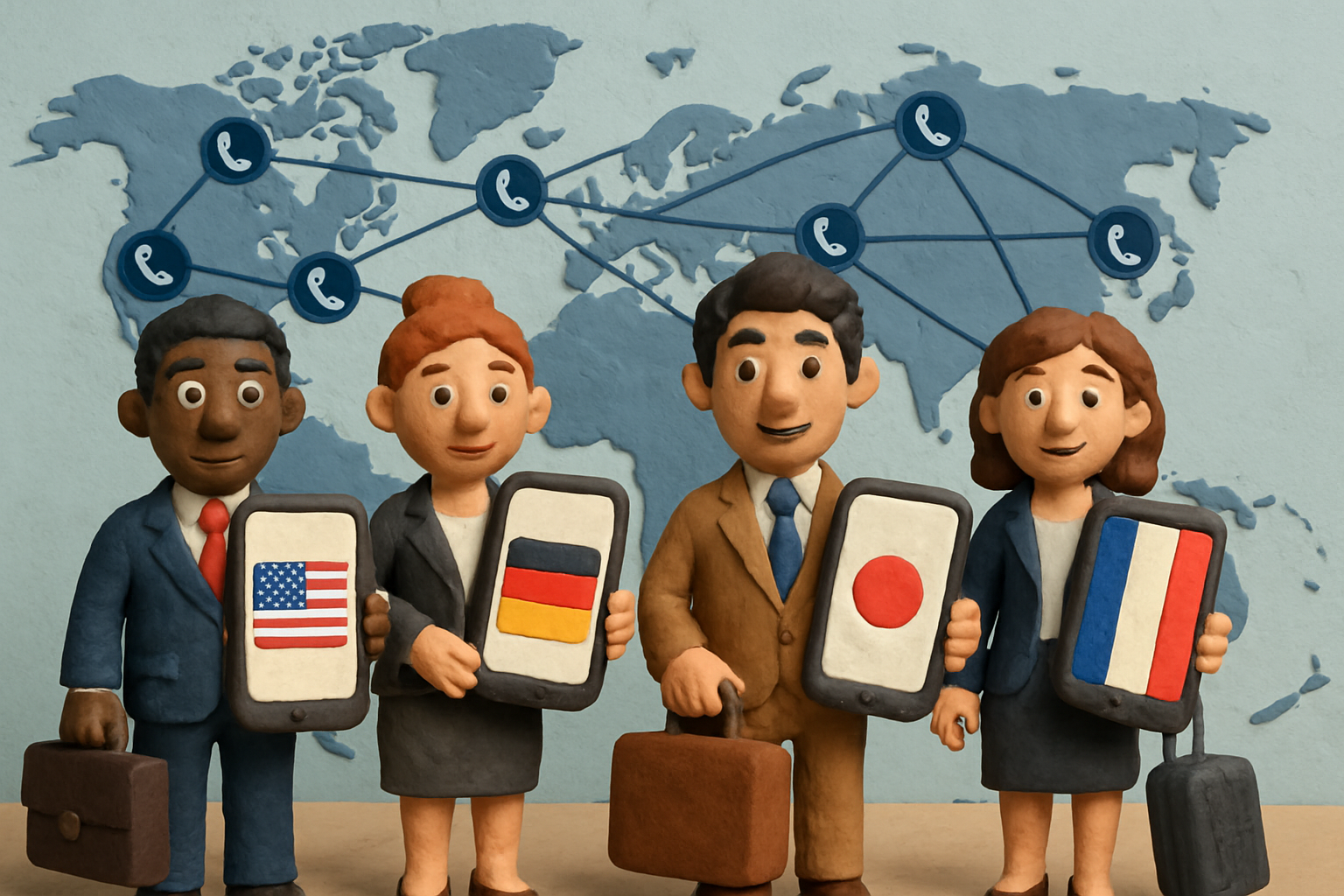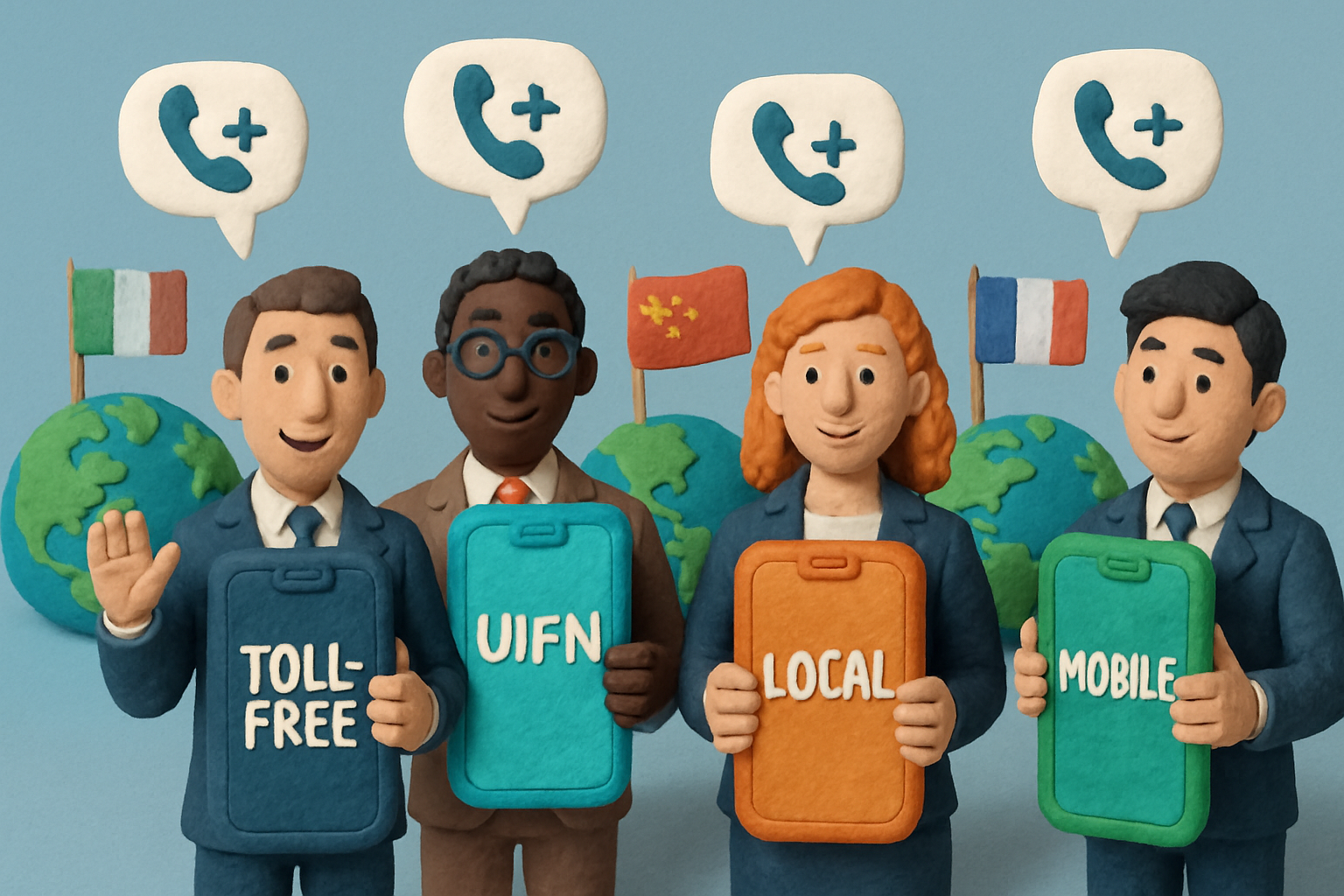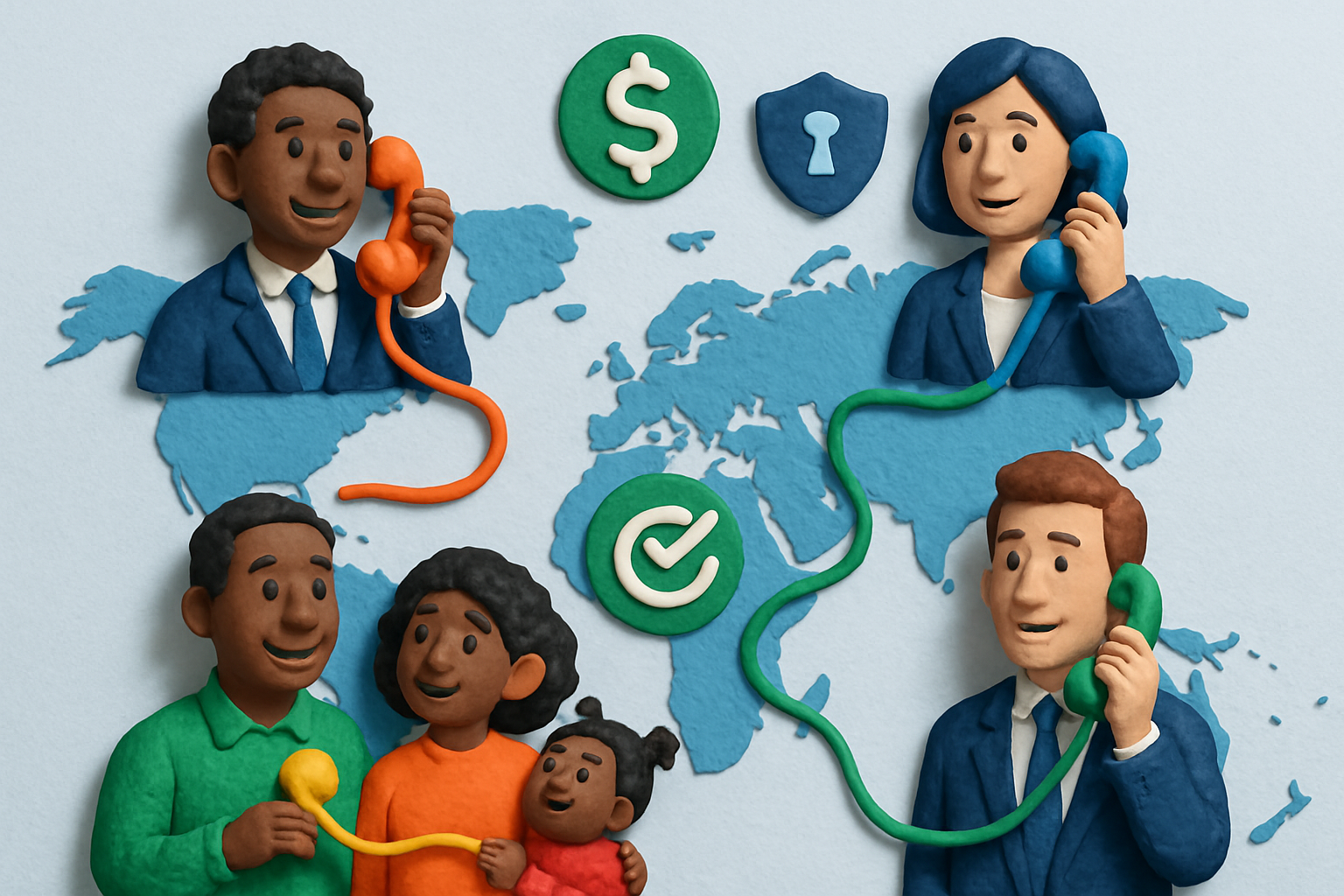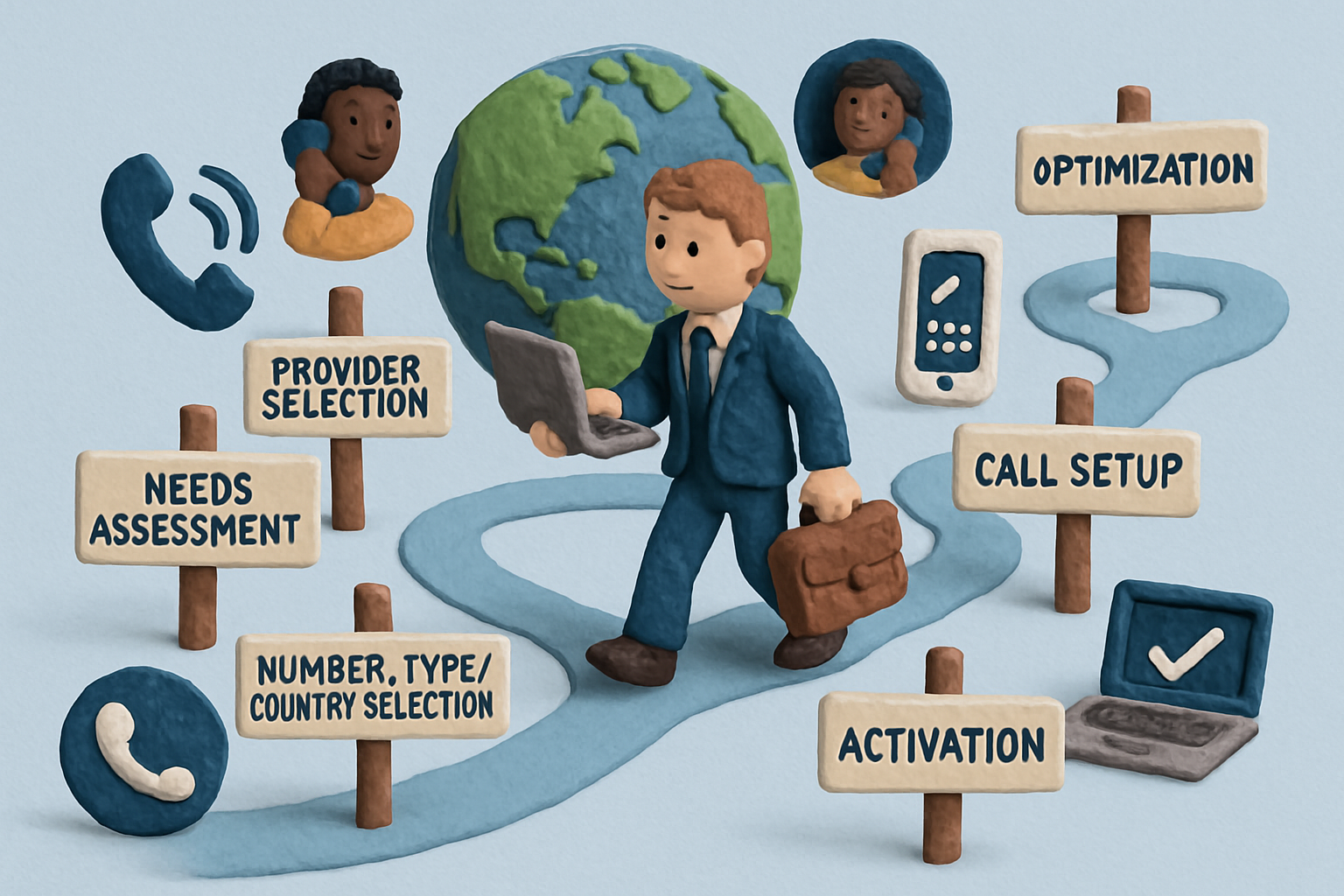
In 2025, seamless international communication is more critical than ever for businesses and individuals expanding across borders. The world is more connected, with global remote work, digital nomadism, and multinational operations on the rise.
Adopting an international virtual phone number is a powerful way to remove barriers, cut costs, and create a local presence anywhere in the world.
This comprehensive guide will help you make smart choices for your global communication needs. You'll learn what international virtual phone numbers are, how they work, the types available, their benefits, how to get them, regulatory considerations, and what features matter most.
What is an International Virtual Phone Number?
Understanding the international virtual phone number is the first step toward unlocking seamless global communication in 2025. Unlike traditional numbers, these are not tied to any single device or geographic location. Instead, they offer flexibility for businesses and individuals looking to connect across borders with ease.

Definition and Core Concept
An international virtual phone number is a telephone number that exists independently of any physical phone line or location. Instead of being linked to a local landline, it operates entirely in the cloud, allowing calls to be forwarded to any device worldwide.
Traditional phone numbers are fixed to a specific region and often to a single device. In contrast, an international virtual phone number can be managed from anywhere, giving users the freedom to receive calls wherever they are. For example, a US-based company can acquire a Singapore virtual number and receive calls from Singaporean clients on their US support team’s mobile phones. This flexibility makes the international virtual phone number ideal for both businesses expanding globally and individuals wanting a local presence in another country.
How International Virtual Phone Numbers Work
When someone calls your international virtual phone number, the call is routed through cloud-based VoIP systems. This technology sends the call to your chosen destination—be it a mobile, landline, or desktop app—anywhere in the world.
International call forwarding is the backbone of this setup. You can easily change where calls go, making it perfect for remote teams and distributed operations. For instance, a company might use a UK virtual number to let customers call a London line, but have those calls ring at a call center in India. This efficiency allows global connectivity without the hassle of multiple physical offices.
International Phone Number Formats
Every international virtual phone number follows a structured format to ensure global accessibility. Typically, it includes the plus sign (+), a country code, an area or toll-free code, and the subscriber number. Here’s how it looks:
+ [Country Code] [Area/Toll-Free Code] [Subscriber Number]
Let’s compare some common formats:
| Country | Example Type | Example Number |
|---|---|---|
| US Toll-Free | Toll-Free | +1-800-555-1234 |
| US Local (NY) | Local | +1-212-555-5678 |
| UK Toll-Free | Toll-Free | +44-800-123-4567 |
| France Local | Local | +33-1-23-45-67-89 |
Getting the format right is crucial for seamless international communication. If you need help with country codes or dialing prefixes, check out this international call prefix list for quick reference.
Key Advantages Over Traditional Numbers
International virtual phone numbers offer several standout benefits:
- No need for physical infrastructure or on-site hardware
- Accessible from any location or device
- Cost-effective for international communication
- Lets you establish a local presence in multiple countries
This approach supports business scalability and flexibility. For example, a startup can launch in new markets with local numbers—without opening physical offices. The international virtual phone number removes barriers, making global expansion more affordable and efficient for everyone.
Types of International Virtual Phone Numbers
Choosing the right international virtual phone number can feel overwhelming with so many options on the market. Whether you want to create a local presence, enable toll-free support, or run a global campaign, understanding the main types is essential. Each type of international virtual phone number offers unique advantages and suits different business or personal needs. For more on how these numbers are transforming global communication, see the Virtual phone numbers in 2025 resource.

International Toll-Free Numbers (ITFN)
An international toll-free number (ITFN) allows callers within a specific country to reach your business for free. The business pays for all inbound calls, making it ideal for customer support and sales hotlines. Common prefixes include 800 and 888 for the US, and 0800 or 0808 in the UK.
With this international virtual phone number type, your business can appear local and accessible, even if your operations are entirely remote. For example, a US-based company can set up a German toll-free number to let German customers call without international charges.
- Callers dial a familiar, toll-free number
- You receive calls wherever you choose
- Boosts customer engagement and trust
Universal International Freephone Numbers (UIFN)
Universal International Freephone Numbers (UIFN) are unique because a single international virtual phone number can be accessed from over 45 participating countries. While UIFN is convenient for global campaigns, it does carry a higher cost and not all countries support this option.
A multinational company can use a UIFN to provide pan-European support, letting customers from France, Germany, or Spain dial the same number. However, always check if your target countries support UIFN before committing.
- One number, global reach
- Higher setup and maintenance costs
- Check country participation before purchase
Local (Geographic) Virtual Numbers
A local international virtual phone number is assigned to a specific city or region, such as London, Tokyo, or Sydney. Callers pay standard local rates, and your business is seen as a local entity, which builds trust and encourages more calls.
For example, an e-commerce brand expanding into France and Germany might use Paris and Berlin numbers to connect with local customers. These numbers are perfect for market entry and establishing a local footprint quickly.
- Display local area codes
- Easier customer adoption
- Flexible routing to any device
National Virtual Numbers
A national international virtual phone number covers an entire country, rather than just one city or region. This type is ideal for companies serving customers nationwide, without the need to maintain multiple local numbers.
For instance, an Italian business can use a national number to serve clients from Milan to Sicily, all through a single point of contact. National numbers help simplify marketing and customer support across diverse regions.
- One number for the whole country
- Uniform brand identity
- Great for centralized support
Mobile Virtual Numbers
Mobile virtual numbers resemble standard mobile numbers in the target country and support both SMS and voice. This international virtual phone number type is especially useful for two-way communication, marketing, and services like OTP (one-time password) delivery.
A SaaS provider targeting India might use mobile numbers to send verification codes and receive customer SMS replies seamlessly. These numbers boost engagement by letting customers interact the way they prefer.
- Looks and works like a mobile number
- Supports SMS and calls
- Ideal for interactive services
Benefits of International Virtual Phone Numbers in 2025
Unlocking the full potential of global communication is easier than ever with the right international virtual phone number. Whether you’re running a growing business or just want to stay in touch with loved ones abroad, the benefits in 2025 are too good to ignore.

Business Benefits
For businesses, an international virtual phone number is a game-changer. Instantly establish a local presence in new markets without the expense of setting up physical offices. Customers are far more likely to call a local number, boosting inbound sales and inquiries.
Remote and distributed teams can collaborate seamlessly, handling calls from anywhere. Companies like Nokia saw up to a 38% productivity increase by adopting virtual numbers. Want to see how global enterprises leverage these numbers? Check out this guide on virtual numbers for global enterprises for real-world strategies.
Individual and Personal Use Cases
An international virtual phone number isn’t just for big business. Individuals benefit, too. Expats, students, and travelers can maintain a local number, making it easy and affordable for family, friends, and contacts to reach them.
For example, a Brazilian expat living in the US can receive calls from Brazil as if they were still at home. This keeps personal connections strong and avoids the high costs of roaming or international long-distance fees.
Cost Savings and Flexibility
International calling can be expensive, but an international virtual phone number can reduce those costs dramatically. Forget about pricey roaming charges; pay only for the features and minutes you actually use.
Scaling up or down is easy. Whether you need a single number or dozens for a global campaign, flexibility is built-in. According to ZippCall, businesses can save up to 90% compared to traditional phone companies—a difference that matters on every balance sheet.
Enhanced Features and Integrations
A modern international virtual phone number comes packed with advanced features. Think call forwarding, IVR menus, voicemail-to-email, call recording, and detailed analytics—all at your fingertips.
Integration with tools like HubSpot, Salesforce, and Zendesk makes it simple to keep your communication workflows running smoothly. These features empower both businesses and individuals to manage calls more efficiently and professionally.
Building Trust and Brand Reputation
Trust is everything in global communication. Using a local or toll-free international virtual phone number makes your business appear established and approachable in any region.
Customers are more likely to answer calls from familiar local numbers, increasing engagement and satisfaction. Toll-free options also remove cost barriers, inviting more people to connect with you. A consistent presence worldwide strengthens your brand’s reputation and keeps you top of mind, no matter where your audience lives.
How to Get an International Virtual Phone Number: Step-by-Step Guide
Ready to unlock global communication for your business or personal needs? Getting an international virtual phone number is easier than you might think. Follow this step-by-step guide to ensure you choose the right number, provider, and features for seamless international connectivity.

Step 1: Identify Your Communication Needs
Start by mapping out why you need an international virtual phone number. Are you launching into new markets, supporting remote teams, or staying connected while abroad?
- Pinpoint your target countries or regions.
- Estimate expected call volumes.
- Decide if you need local, toll-free, national, or mobile numbers.
- List essential features like SMS, call forwarding, or IVR.
For example, a marketing team targeting France and Germany may opt for local numbers in Paris and Berlin to increase engagement. By clarifying your needs up front, you’ll set the foundation for a successful international virtual phone number strategy.
Step 2: Research and Compare Providers
Not all providers are created equal. Take time to compare coverage, pricing, features, and customer support before committing to any international virtual phone number.
- Look for transparent pricing and clear service agreements.
- Check if providers offer numbers in your desired countries.
- Review feature lists: call routing, analytics, integrations, etc.
- Read customer reviews and check for hidden fees.
For a comprehensive overview, check out the Best affordable international call services, which highlights top providers that often offer international virtual phone number options.
Step 3: Select Number Type and Country
Once you’ve narrowed down your provider, it’s time to choose the right type of international virtual phone number and the country you want to establish a presence in.
- Decide between local, toll-free, national, or mobile numbers.
- Consider regulatory requirements—some countries need documentation or a local address.
- Think about your audience: Local numbers build trust; toll-free numbers remove barriers for callers.
For instance, a US-based company expanding into Japan might choose a Tokyo local number to establish credibility and make it easy for Japanese clients to reach them.
Step 4: Configure Call Forwarding and Features
After selecting your international virtual phone number, customize its setup to fit your workflow. This step is where you tailor the experience for both your team and your callers.
- Set call forwarding destinations: mobile, landline, VoIP, or desktop app.
- Enable features like IVR menus, voicemail-to-email, call recording, or SMS.
- Configure business hours and time-based routing.
Example: Forwarding calls from a UK virtual number to a US support center ensures your customers always reach a live agent, no matter the time zone.
Step 5: Purchase and Activate the Number
Purchasing your international virtual phone number is straightforward, but pay attention to the details to avoid delays.
- Complete your provider’s signup process.
- Submit any required documents (ID, proof of address, business registration).
- Make your payment and wait for confirmation.
Activation times can vary depending on the country and number type. Some providers activate numbers instantly, while others may take a few business days. Keep an eye on your inbox for activation updates or instructions from your provider’s support team.
Step 6: Test and Optimize
With your international virtual phone number live, it’s time to ensure everything works perfectly and make adjustments as you go.
- Place test calls from different locations to confirm call quality and routing.
- Monitor analytics for missed calls, response times, and user behavior.
- Adjust features or call destinations based on real-world feedback.
Continuously optimizing your setup ensures you get the most value from your international virtual phone number and keep your communications running smoothly.
Regulatory, Privacy, and Compliance Considerations
Staying compliant while using an international virtual phone number is crucial for businesses and individuals. Regulations evolve rapidly, and privacy laws are tightening worldwide. Understanding these requirements ensures smooth, legal, and secure communication across borders.
Country-Specific Regulations
Each country has its own rules for international virtual phone number usage. Some require a local business presence or specific documents before issuing numbers. For example, countries like China and India often impose strict controls on number types or call forwarding features.
It's also common for certain regions to restrict Universal International Freephone Numbers (UIFN), limiting their availability. Regulatory trends are shifting as governments aim to reduce telecom fraud and improve traceability. For a deeper dive into these evolving requirements, see this Global regulatory trends: tightening net on fraud article. Always check country-specific guidelines before acquiring a new international virtual phone number.
Data Privacy and Security
Protecting user data is a top priority when using an international virtual phone number. Providers must comply with privacy regulations like GDPR in Europe or CCPA in California. This means securing call data, using encrypted communication channels, and safely storing personal information.
Look for providers that offer end-to-end encryption and transparent privacy policies. Many top platforms now feature secure data centers and automated data retention controls. Choosing a compliant provider ensures your international virtual phone number remains a safe and trustworthy choice for global communication.
Number Portability and Ownership
Portability is a valuable feature for any international virtual phone number. It allows users to transfer numbers between providers without losing business continuity. Before choosing a provider, confirm their policies on number ownership and portability.
This flexibility is especially important for businesses scaling operations or relocating support centers. For example, porting a UK international virtual phone number from one provider to another can help maintain customer contact without interruption. Always clarify portability options before making a commitment.
Emergency Calling Limitations
Most international virtual phone number services do not support emergency calling, such as 911 or 112. This limitation arises because virtual numbers are not tied to a specific geographic location. Providers must clearly state these restrictions in their user agreements.
If emergency access is essential, consider alternative solutions or backup devices. Always inform your team or family about these limitations when relying on an international virtual phone number for daily communication. Safety should remain a top concern with any virtual telephony solution.
Key Features to Look for in 2025 International Virtual Phone Number Providers
Choosing the right international virtual phone number provider can feel overwhelming, but focusing on a few key features makes it much easier. In 2025, the right provider should empower your business or personal communication with seamless connectivity, flexibility, and transparency.
Call Quality and Reliability
When selecting an international virtual phone number, call quality is non-negotiable. Look for providers that offer HD voice, global infrastructure, and strong uptime guarantees. Service Level Agreements (SLAs) and real-time network monitoring help ensure your calls are crisp and uninterrupted.
Did you know that VoIP adoption in remote teams grows by 47% in 2022? This surge highlights why reliability is critical for any international virtual phone number solution. In today's global landscape, even a few dropped calls can impact your reputation.
Providers often boast "crystal-clear, high-definition audio," so always check for independent reviews and test call quality before committing.
Flexible Call Routing and Forwarding
A standout international virtual phone number provider offers flexible routing to any device—mobile, landline, SIP, or app. Whether you need to route calls based on time zones or to specific teams, advanced routing options help you stay responsive.
Features like time-of-day routing, skill-based routing (such as CloudTalk’s solutions), and simultaneous ringing can transform your customer experience. This flexibility is essential for businesses with remote or distributed teams around the world.
Imagine being able to forward calls to different continents depending on business hours. That’s the true power of a modern international virtual phone number.
Advanced Communication Features
The best international virtual phone number providers offer more than just voice. Essential tools include IVR (interactive voice response), call recording, voicemail-to-email, SMS, and even AI-powered call transcription.
These advanced features streamline communication and support compliance. Analytics and real-time reporting dashboards help you monitor performance and make informed decisions.
For example, Global Call Forwarding’s AI Call Insights and call transcription capabilities can elevate your team’s productivity and customer insights.
Integration Ecosystem
A robust integration ecosystem is a must-have for any international virtual phone number provider in 2025. Look for native integrations with CRM systems like Salesforce, HubSpot, or Zoho, as well as helpdesk tools such as Zendesk.
API access is also valuable for building custom workflows and automating processes. Seamless integration ensures your virtual phone system fits perfectly into your existing tech stack, reducing manual tasks.
If your provider supports these integrations out of the box, you’ll save hours on setup and maintenance.
Scalability, Support, and Pricing Transparency
Scalability means you can add or remove numbers and users as your needs change. Reliable international virtual phone number providers offer easy management portals and instant activation.
Transparent pricing is equally important. Look for clear rate calculators, pay-as-you-go or subscription options, and no hidden fees. 24/7 customer support and onboarding assistance round out the package.
Prioritizing these features ensures your international virtual phone number investment is future-proof and hassle-free.
Use Cases and Real-World Examples
International virtual phone number solutions are transforming how people and businesses connect across borders. Whether you’re a global enterprise, a remote team, or an expat, these numbers open doors to seamless communication and opportunity.
Global Business Expansion
For companies looking to expand globally, an international virtual phone number makes it possible to enter new markets without the cost and hassle of opening physical offices. For example, an e-commerce company based in the US can set up local numbers in ten countries to build trust with overseas customers.
- Launch marketing campaigns with local numbers.
- Receive calls from customers in their native language.
- Test new markets quickly and cost-effectively.
With an international virtual phone number, businesses can respond to local leads as if they were right next door. Curious about dialing conventions in different regions? This Guide to making international calls is a helpful resource.
Customer Support and Sales Optimization
Customer support is one of the most common use cases for an international virtual phone number. Toll-free and local numbers encourage more customer inquiries and make it easier to provide timely support.
- Set up toll-free lines for sales and support hotlines.
- Route calls to distributed teams based on time zones.
- Improve answer rates with familiar local numbers.
A real-world example: Nokia improved team productivity by 38% after adopting international virtual phone number systems, allowing them to route calls globally and ensure customers always reach the right department.
Remote Teams and Virtual Offices
Virtual offices and remote teams thrive with the flexibility of an international virtual phone number. Distributed staff can answer calls from anywhere, supporting global collaboration.
- Assign numbers to remote employees regardless of location.
- Forward calls to mobile devices, desktops, or softphones.
- Maintain a unified business presence worldwide.
This approach makes it simple for startups and established businesses alike to scale their teams internationally, all while keeping communication centralized and professional.
Personal and Family Connectivity
Individuals also benefit from an international virtual phone number. Expats, students, and travelers often need to stay connected to loved ones or important contacts back home.
- Receive calls on a local number, no matter where you live.
- Avoid expensive roaming charges while abroad.
- Maintain privacy when sharing a contact number in a new country.
Imagine a student from India studying in the UK who keeps an Indian international virtual phone number. Family and friends can reach them easily, and they can manage calls and messages as if they never left home.
Frequently Asked Questions About International Virtual Phone Numbers
Curious about how an international virtual phone number works? Here are quick answers to the most common questions:
-
What is the difference between local and toll-free virtual numbers?
Local numbers match a city or region, while toll-free numbers let callers reach you at no cost within the country. -
Can I use a virtual number for SMS and voice?
Yes, most international virtual phone number providers support both, but check specific country rules. -
How quickly are virtual numbers activated?
Many numbers activate instantly, but some countries require extra verification. -
What documents are required to purchase a number?
You may need proof of identity or business registration, depending on the country. -
Can I port my existing number to a virtual provider?
Many services allow porting, but eligibility depends on your provider and region. -
Are there any restrictions on call forwarding destinations?
Some countries have rules about where you can forward calls, so review your provider’s policies. -
How is call quality ensured for international calls?
Providers use reliable global networks and VoIP tech for clear connections. For more on affordable calling, see this free international calls guide.
Now that you know how international virtual phone numbers can open doors for your business or personal life in 2025, why not see how easy it is to connect globally yourself? With ZippCall, you don’t need to worry about complex setups or hidden fees—just simple, reliable calling from your browser or phone, pay-as-you-go, and no strings attached. Whether you want to reach clients overseas or keep in touch with loved ones, your global presence is just a click away. Ready to experience the difference? Start Calling and see how seamless international communication can be!
Ready to Try ZippCall?
Make affordable international calls on web, iPhone, and Android devices. Crystal-clear quality with competitive rates.
1 minute setup. No subscription required.